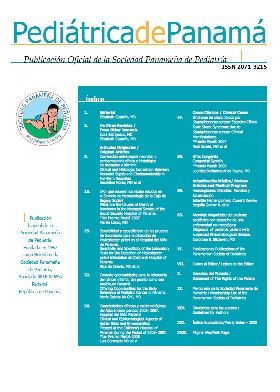Riesgo nutricional de pacientes hospitalizados en el Hospital de Especialidades Pediátricas “Omar Torrijos Herrera”
[Nutritional screening of hospitalized patients at Hospital de Especialidades Pediátricas Omar Torrijos Herrera]2021-10-12
Descargas
Palabras clave:
riesgo nutricional, tamizaje, desnutrición intrahospitalariaKeywords:
nutritional risk, screening, hospitalized malnutritionResumen
Introducción: La desnutrición intrahospitalaria tiene grandes implicaciones socio-económicas para los países. Sus manifestaciones dependen del grado, tiempo de evolución, déficit ponderal y edad del niño. El objetivo de este estudio es conocer el riesgo nutricional de los pacientes hospitalizados en la Sala de Medicina del Hospital de Especialidades Pediátricas.
Métodos: Estudio descriptivo, transversal, pacientes de ambos sexos de 1 mes a 15 años de edad, ingresados a la sala de medicina del Hospital de Especialidades Pediátricas en noviembre de 2014. Se aplicaron dos métodos de tamizaje nutricional, Screening Tool for Assessment of Malnutrition in Paediatrics (STAMP) y Screening Tool for Risk On Nutritionational status and Growth (STRONGKIDS) y se estableció el riesgo nutricional de cada sujeto en estudio.
Resultados: 147 pacientes participaron en el estudio. La edad promedio fue de 4,5 años (DE: 4,8), la mayoría eran lactantes (50,3%), con predominio del sexo masculino (56%). Se encontró desnutrición al momento del ingreso en el 12,8% y sobrepeso-obesidad en el 26,6%. STAMP clasificó al 18,3% de la muestra con riesgo nutricional elevado. Dicho método mostró una sensibilidad 57,8% y una especificidad del 87,5%. En cuanto a la prueba de tamizaje STRONGKIDS identificó a un 12,2% con riesgo elevado, con una sensibilidad de 47,3% y especificidad del 92,3%. La concordancia (k) entre STAMP y la evaluación nutricional fue de 0,38 y en el caso de STRONGKIDS fue de 0,41.
Conclusiones: Podemos concluir que la prevalencia de desnutrición al momento del ingreso fue del 12,8%. Ambas pruebas de tamizaje nutricional mostraron una buena especificidad (>80%). El riesgo nutricional se correlaciona con las medidas antropométricas principalmente en STRONGKIDS.
Abstract
Introduction: Malnutrition in hospitalized patients is a prevalent condition and is
associated with many adverse outcomes. It depends on the degree, time of evolution, weight deficit and age of the child. There is a direct relationship between nutritional deterioration and longer hospitalization time, causing an increase in the frequency of complications and increased mortality. The objective of this study is to know the nutritional risk of hospitalized patients at Hospital de Especialidades Pediátricas Omar Torrijos Herrera.
Methods and materials: Cross-sectional descriptive study with patients evaluated within 48 hours of admission. Patients were aged 1 month or older, both sexes, admitted to the medicine room at Hospital de Especialidades Pediátricas in November 2014. Nutritional risk was assessed by two nutritional screening methods: STAMP and STRONGKIDS. Nutritional status was classified through anthropometric measurements. The study was approved by the Research Ethics Committee and the signing of the informed consent was required before its inclusion in the study.
Results: We evaluated 147 patients aged 4.5 ± 4.8 years, 50.3% were infants and with a predominance of males (56%). The prevalence of malnutrition was 12.8% and for overweight-obesity was 26.6%. STAMP classified 18.3% of patients as high nutritional risk. This method showed a sensitivity of 57.8% and a specificity of 87.5%. Regarding, STRONGKIDS identified 12.2% of patients at high risk, with a sensitivity of 47.3% and specificity of 92.3%. The concordance (k) between STAMP and nutritional evaluation was 0.38 and in the case of STRONGKIDS it was 0.41.
Conclusion: The prevalence of malnutrition at the time of admission was 12.8%. STAMP and STRONG KIDS demonstrated high specificity. Nutritional risk is correlated with anthropometric measures mainly in STRONGKIDS. Further studies are required to analyze these tools and nutritional interventions derived from them.
Licencia
Derechos de autor 2021 Infomedic InternationalDerechos autoriales y de reproducibilidad. La Revista Pediátrica de Panamá es un ente académico, sin fines de lucro, que forma parte de la Sociedad Panameña de Pediatría. Sus publicaciones son de tipo ACCESO GRATUITO y PERMANENTE de su contenido para uso individual y académico, sin restricción. Los derechos autoriales de cada artículo son retenidos por sus autores. Al Publicar en la Revista, el autor otorga Licencia permanente, exclusiva, e irrevocable a la Sociedad para la edición del manuscrito, y otorga a la empresa editorial, Infomedic International Licencia de uso de distribución, indexación y comercial exclusiva, permanente e irrevocable de su contenido y para la generación de productos y servicios derivados del mismo.






